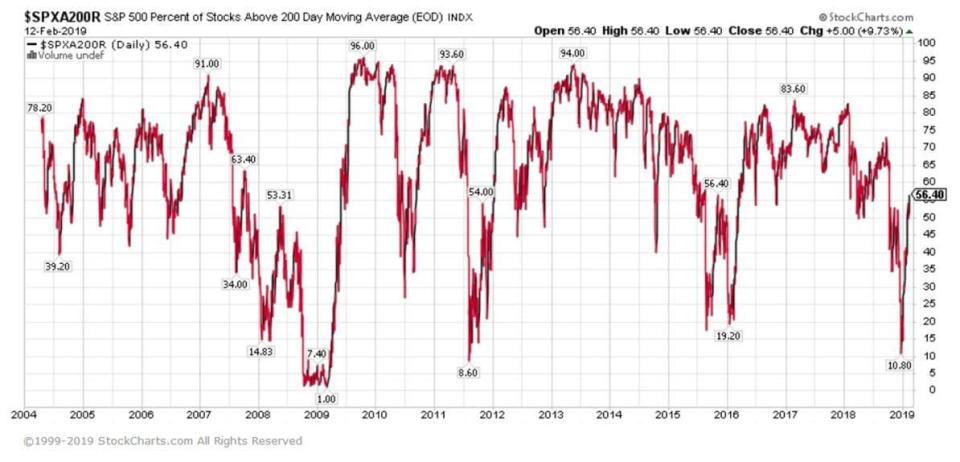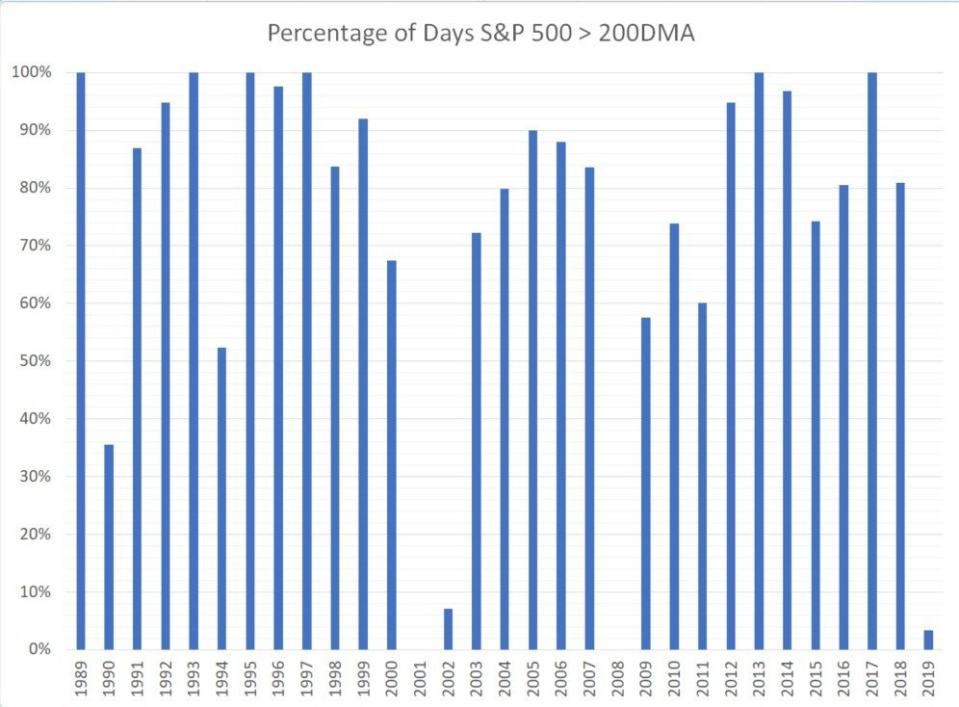The first sign to look for to tell if the market or a stock is healthy
The 200-day moving average (200 DMA) is one of the most popular indicators that technicians use to analyze price trends. This indicator represents the average closing price of a security or an index over the past 200 days. There are numerous ways to use the 200 DMA depending on which type of investor you are.
For example, value investors might be inclined to buy dips and search for bargains when prices are significantly below their 200 DMA. Meanwhile, growth investors may wait for prices to be above the 200 DMA because momentum and “breakout” strategies tend to fail when below this key indicator.
The following chart shows the percentage of stocks in the S&P 500 that are above the 200 DMA.

Looking back less than two months ago on Christmas Eve, there were only 10.8% of stocks in the index that were above the 200 DMA. This was the lowest percentage reading since mid-2011. Using history as a guide, any time this percentage has dipped to approximately the 20% level, it has been a relatively bullish sign for stocks for investors with longer timeframes. Even the most recent event has produced nearly a 17% rally in less than two months. Many value investors I know were putting money to work around the end of December 2018, while many growth managers had larger cash positions and were waiting for confirmation of a new uptrend.
On Tuesday, February 12, the S&P 500 closed above its 200 DMA for the first time in 2019. I became curious about how often the market trades above the 200 DMA each year. The following chart shows this data going back 30 years:

Here are a few important observations about this chart:
1) Every time the S&P 500 was above the 200 DMA for less than 40% of the year, the U.S. entered into a recession (1990 into 1991, 2001 into 2002, and 2008 into 2009).
2) 20% of the years have concluded with 100% of the days above the 200 DMA.
3) In 2001 and 2008, the S&P 500 was not above the 200 DMA for a single day.
4) Based on the past 30 years, the S&P closes above the 200 DMA 75% of the time on average.
I often get asked “What’s the first sign you look for to tell if the market or a stock is healthy?” I always answer, “If it’s above its 200 DMA.” Why? Because I view this level as a red light or green light to indicate if the large institutions are selling or supporting the market or a stock. Also, studies show that 99% of big winning stocks were above their 200 DMA BEFORE going on to achieve tremendous gains.
As a growth manager, I especially want to see things above their 50 DMA to confirm further strength and signs of a strong uptrend. Let’s hope for the bulls’ sake that we start spending more time above this key indicator in 2019 and avoid any potential recession.
Read more:
Why FAANG stocks might be dead money for a while
The market moves because of 2 main factors
Why enterprise software is emerging as one of the market’s strongest sectors
I can be reached at: [email protected]
Disclaimer: This information is issued solely for informational and educational purposes and does not constitute an offer to sell or a solicitation of an offer to buy securities. None of the information contained on this site constitutes a recommendation that any particular security, portfolio of securities, transaction, or investment strategy is suitable for any specific person. From time to time, the content creator or its affiliates may hold positions or other interests in securities mentioned on this site. The stocks presented are not to be considered a recommendation to buy any stock. This material does not take into account your particular investment objectives. Investors should consult their own financial or investment adviser before trading or acting upon any information provided. Past performance is not indicative of future results.